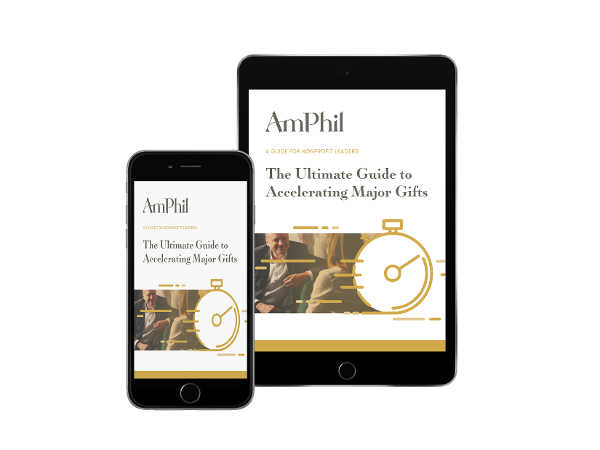
To many nonprofit leaders, foundations feel like a mystery.
They give out grants, but how do they choose their grantees? When’s the right time to ask? And what do you do when they say, “We’re not accepting proposals right now”?
It’s easy to feel stuck. But, *drumroll* the good news is:
Foundations aren’t an enigma. They’re people. And they care about the same things you do: impact, mission, and trust.
In this article, we’ll walk through what foundation relationships actually look like, how to start and maintain them, why “not now” doesn’t mean “never,” and how real nonprofits are seeing major results by focusing on connection over perfection.
"We're Not Accepting Proposals Right Now."
If you’ve heard this sentence from a foundation before, you’re not alone.
Maybe the foundation says it’s a tough market year. Or their budget’s already spoken for. Or they only consider “invited proposals.”
That might sound like a firm no, but before you give up hope, it helps to see things from the foundation’s side. Usually, when they say that, it just means they don’t really know you yet. If you aren’t reaching out or showing you care about the same things they do, they have no reason to think you’re a good fit for their mission.
What the foundation really means is, “Keep in touch with us.” And that means:
-
Keeping them updated on your work.
-
Reaching out with relevant touchpoints.
-
Being present, so that when they are ready to give, your name is already at the top of their list.
Foundation Funding is a Long Game
Most nonprofits receive 30–40% of their revenue from foundations. So yes, grants really do matter in a nonprofit's budget.
But getting support from foundations takes time. It’s not just about writing the best grant request. It’s about getting to know the people at the foundation and building genuine relationships, which doesn’t happen overnight.
That means:
-
Reaching out even when you don’t need something.
-
Asking how their priorities are shifting this year.
-
Letting them know how your work is going.
-
Listening first, then proposing something that fits.
This relationship-first approach aligns closely with trust-based philanthropy principles growing across the sector.
What Does It Mean to Build a Relationship
In conversations we’ve had with nonprofit professionals, a few common questions always come up:
-
How do I start the relationship?
-
What do I say if I’m not asking for money yet?
-
Isn’t it kind of transactional?
-
What if I’m not good at networking?
These are real concerns, and they’re understandable.
But relationship-building, when you're fundraising, isn’t about schmoozing as much as it may feel that way. After all, isn't the end goal a gift? However, it's important to remember that you should build a foundation of trust, clarity, and consistency.
You don’t have to be best friends with a program officer. You do need to respect their time, understand their goals, and stay in touch in meaningful ways.
A Simple Framework to Start the Relationship
1. Do your homework.
Know the funder’s priorities, past grantees, and giving history. Research the foundation’s past grantees and priorities using tools like Candid’s Foundation Directory. You can also look up past grant recipients through IRS 990 forms to understand giving patterns.
2. Reach out with purpose.
Start with a short, respectful email. Example:
“Hi (Name), I saw your foundation supported (Similar Organization) last year. I’d love to understand better how your priorities are evolving and whether our work might be a fit in the future. Would you be open to a brief call or coffee?”
This shows you’ve done your research, and you’re not asking for money, just insight.
3. Make it personal and specific.
Reference a recent grant of theirs or something from their website, for example:
“We saw your foundation recently supported community mental health efforts in rural areas. We’re launching a similar program this fall, happy to share what we’re learning if that’s helpful.”
This helps them see you're aligned and not just reaching out at random.
4. Share without asking.
Send a short story, a video clip, or a photo with a brief note:
“Just wanted to share a 2-minute clip from our program last week. It reminded us why we do this work. Hope it makes you smile.”
Or:
“We’re hosting a site visit for local partners next month. If anyone from your team is nearby, we’d love to have you.”
No pitch, just a window into your impact.
5. Follow up thoughtfully.
Set a quarterly reminder to check in with a tailored update. Avoid mass newsletters. Make your touchpoint relevant to something they care about or have funded before.
As you start building relationships, it helps to sharpen your grant writing. Grab our free resource: How to Elevate Your Grant Writing in 6 Steps.
If You're Not a Natural Networker
That’s okay. You don’t need to be charming or outgoing. You just need to:
-
Communicate clearly.
-
Focus on the mission, not yourself.
-
Show up consistently.
Think of yourself as someone who speaks up for your organization. You don’t have to be chatty or outgoing. Quiet leaders who care deeply and listen well can build strong relationships just as well as their larger than life counterparts.
Real Results
We worked with a media and advocacy nonprofit that had a strong reputation and loyal donors, but struggled to make progress with foundation fundraising.
They weren’t sure where to start. So we helped them:
-
Craft clear messaging for funders.
-
Identify aligned prospects hiding in their own database.
-
Reach out through personal, consistent communication.
The result?
- $1 million in new foundation grants.
- $500,000 from a single new funder.
- A 10:1 return on their investment.
They didn't find the perfect words to put in their proposal, but they did build a real relationship with people who cared.
You can explore more nonprofit success stories to see how this relationship-first approach pays off.
What You Can Do Right Now
Here’s what we recommend:
- Stay in touch even when a check isn’t coming tomorrow.
- Ask smart questions like “What’s new in your funding priorities this year?”
- Share updates not just results, but stories, milestones, and moments of progress.
- Be a partner, not a pitch.
And always remember:
Foundations are made up of people. When you treat them like partners (not vending machines), you build relationships that actually work.
How We Help
At AmPhil, we help nonprofits build strong, lasting relationships with foundations and then put those into words with clear, compelling grant writing.
We’ve worked with hundreds of organizations to grow foundation support, navigate tricky conversations, and make the ask with confidence.
We’d love to help you do the same. If you're thinking about how foundation relationships fit into your broader fundraising strategy, our nonprofit consulting team can help.


